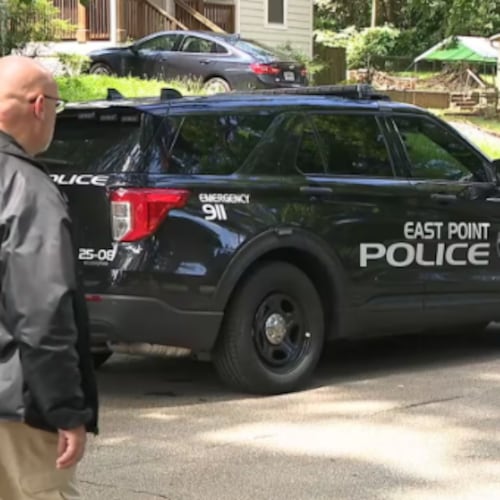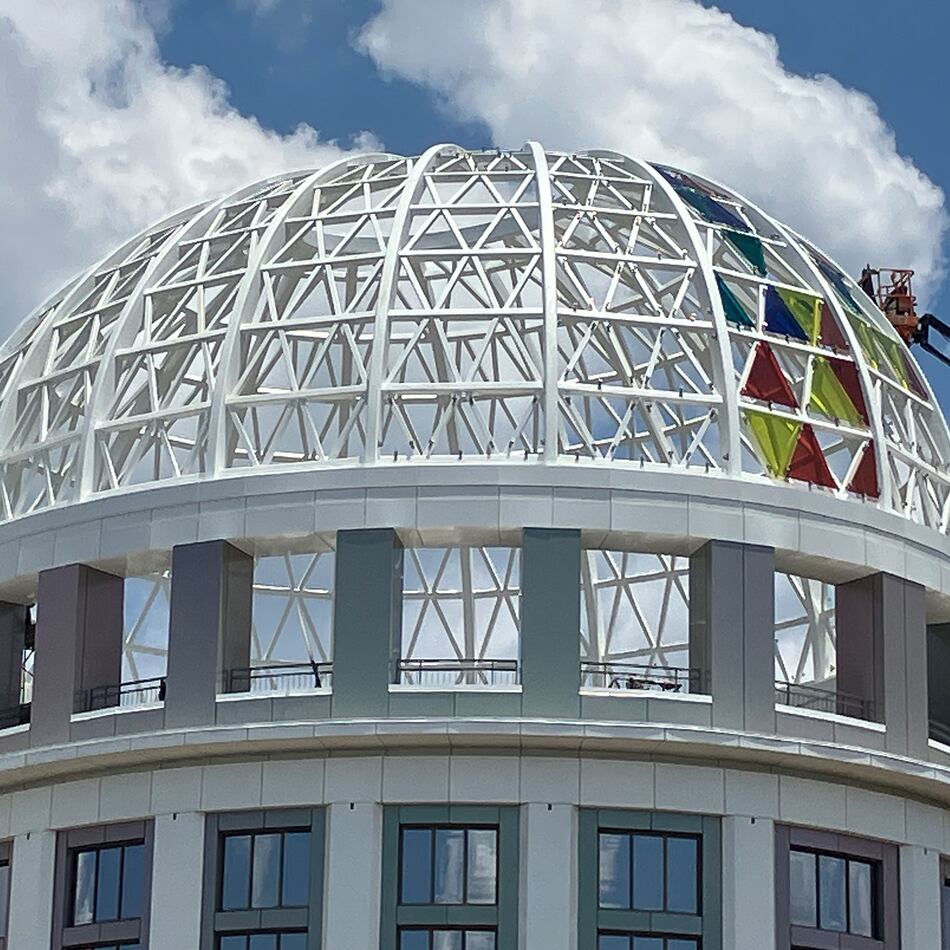Even on his knees, the man is very tall. His dark outline covers most of a 17-story building. He looks up, hands together in what could be prayer. Something is piercing him just below the throat. A beam of light? A drinking straw? This mural has towered above downtown Atlanta for 14 years, leaving a legacy of confusion.
“I tried to understand the meaning, and I cannot find it,” said Jose Anico, standing on the Courtland Street bridge and examining the mural on a recent afternoon.
“It’s about pollution? It’s about the pipe filling up a human with oil?”
His co-worker Tim Phebus gazed across the distance, toward the eastern wall of the Connally Hotel, and studied the enigmatic figure.
“Now that I look at it, it’s like a CapriSun,” he said.
“Like the dude’s chest being punched by a straw.”
The best public art tells a clear and compelling story. It reminds a community of where it came from or what matters most. New York has the Statue of Liberty. Budapest has the shoes by the river. Atlanta has murals honoring John Lewis and Outkast, and at least four statues of the Rev. Martin Luther King Jr. It also has the giant kneeling man, whose meaning is shrouded in mystery.
The upper part of the figure is an empty outline. The lower part is filled in with black paint. This leads to further speculation. Is he half-full? Being filled up with something? Or half-empty? Being drained?
And being filled with or drained of what, exactly?
Credit: Miguel Martinez-Jimenez
Credit: Miguel Martinez-Jimenez
Closer to the mural, on the Alabama Street plaza of Underground Atlanta, a security guard named Jah’Coby Wheeler looked up at the towering figure and imagined himself there, at a spiritual breaking point, renouncing the darkness before it was too late.
“Like cleanse my soul, or something like that,” he said.
The mural went up in 2011, and readers of The Atlanta Journal-Constitution were soon perplexed. At least two wrote to Andy Johnston, who had a column called Q&A on the News. One reader wrote this:
“A mural appeared about a month ago, about a mile from my office building. At first, everyone thought it was unfinished, but nothing else has been done to it. All day long, office workers gravitate toward the window to look, wonder and discuss what the artist meant. What is this mural and what does it mean?”
Johnston sent an email to the artist, who goes by the name Sam3, and got a cryptic response. The answer appeared in the AJC in 2011 and again in 2014, after another reader said he’d been “trying for years to figure out the meaning.”
According to Johnston’s column, Sam3 offered this for an answer:
“I didn’t paint a 15-story wall to (explain it) in a few words. Sorry, it has no title. If it can help, I can remember an old Chinese proverb: ‘We do not see things as they are, but as we are.’”
And thus Sam3 left the townspeople to their confusion for the next 14 years.
On a sweltering afternoon, with an intricate cloudscape backlit by the sun, a reporter stood on the brick plaza of Alabama Street, seeking insight from passersby.
“Something ain’t right about that picture,” said Kym White, stopping to look up.
She and Eric Johnson searched for clues. Johnson thought the man was having his blood drained. White wondered what was coming out of his throat.
“It’s like a sword,” she said.
Johnson puzzled over the artist’s motives.
“I don’t know what he was thinking,” he said, “the day he made that.”
But more would soon be revealed.
Through a longer email exchange with the artist, as well as interviews with two officials from a nonprofit called Living Walls, a layer of the backstory emerged.
Living Walls works with the city of Atlanta to commission and manage public art projects. In 2011, the group invited an international team of street artists to paint a series of murals. One of them called himself Sam3. He was from Spain.
Sam3 was grateful to Living Walls executive director Monica Campana for getting the mural concept quickly approved. He wrote that “I didn’t have to go through any kind of committee to judge my design. … Normally, on projects of this magnitude, too many people weigh in, and the ideas don’t come to fruition.”
Cumbersome as they might be, those approval committees exist for a reason. At least two other murals from the early years of Living Walls caused so much offense they were removed by popular demand. One featured a part-human, part-crocodilian figure that ruffled feathers in a Pittsburgh neighborhood. Eventually, state workers showed up and made it disappear.
Sam3 encountered resistance at first, but it was only logistical. A massive boom lift was deemed too heavy to rest on Alabama Street, so the team had to find another way. Days went by. Campana said she cried with frustration. Running short on money, she and a few others went to Sunbelt Rentals and pooled their resources to rent a swing stage on which Sam3 would dangle from the top of the building and do his work in a manner similar to a window-washer.
He had help from Escif, another Spanish street artist whose main contribution to the Atlanta cityscape was another perplexing mural: a giant fire extinguisher painted to resemble a Chinese flag.
Credit: Miguel Martinez-Jimenez
Credit: Miguel Martinez-Jimenez
Sam3 and Escif worked hard in the August heat with a large quantity of black latex paint. Campana remembers seeing Sam3 coming down from the stage drenched in sweat and covered in paint. It all gave her a feeling of hope, a sense of accomplishment.
“It’s personal to me,” she said, “because I didn’t think we were gonna be able to paint it.”
As Sam3 dangled above the city, he was visited by an unexpected guest. He took it as a sign. It came out of nowhere, he said. A praying mantis.
Sam3 had previously written that the mural had no title. But in an email in June, he said it did.
“The Prayer.”
We do not see things are they are, but as we are. Fourteen years later, a woman and two boys were walking along Alabama Street, looking up at the mural.
“It signifies hope,” Brandie Dozier said.
“I feel like the man right there, he’s trying to pray,” said Ryan, 8. “And he’s hoping he can get some joy.”
“He’s praying down to his knees to hope that he gets better,” said Ryley, 6. “And he’s trying to follow his dreams.”
Credit: Miguel Martinez-Jimenez
Credit: Miguel Martinez-Jimenez
The next week, on a hot Tuesday morning, a man pushed a rattling cart along the plaza. Ruben Sepulveda, 64, is a maintenance worker for Underground Atlanta. He was sweeping trash off the sidewalk and replacing trash bags. When a reporter approached, he paused to look up at the mural.
It might not be there much longer. Artistic preferences change with the times. Officials from Living Walls said they are exploring a plan to have something new painted there before next year’s FIFA World Cup. The praying man’s days are numbered.
But if he goes, at least one person will miss him.
“Oh yeah,” Sepulveda said when asked if he likes the mural. “I watch it every day.”
Then he got back to work maintaining his corner of Atlanta. A wheel squeaked on the garbage cart. Flags rippled in the breeze. The sun cast diagonal shadows from the lampposts. All around the plaza, the city hummed softly. The man on the wall pressed his hands together and kept looking toward the sky.
About the Author
Keep Reading
The Latest
Featured







